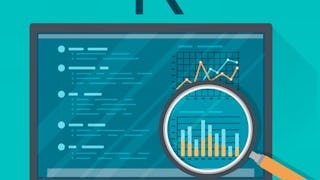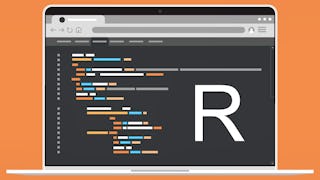This course is the seventh course in the Google Data Analytics Certificate. In this course, you’ll learn about the programming language known as R. You’ll find out how to use RStudio, the environment that allows you to work with R, and the software applications and tools that are unique to R, such as R packages. You’ll discover how R lets you clean, organize, analyze, visualize, and report data in new and more powerful ways. Current Google data analysts will continue to instruct and provide you with hands-on ways to accomplish common data analyst tasks with the best tools and resources.
通过 Coursera Plus 解锁访问 10,000 多门课程。开始 7 天免费试用。


您将学到什么
Describe the R programming language and its programming environment.
Explain the fundamental concepts associated with programming in R including functions, variables, data types, pipes, and vectors.
Describe the options for generating visualizations in R.
Demonstrate an understanding of the basic formatting in R Markdown to create structure and emphasize content.
您将获得的技能
要了解的详细信息

添加到您的领英档案
36 个测验,2 项作业
了解顶级公司的员工如何掌握热门技能

积累 Data Analysis 领域的专业知识
- 向行业专家学习新概念
- 获得对主题或工具的基础理解
- 通过实践项目培养工作相关技能
- 通过 Google 获得可共享的职业证书

该课程共有5个模块
R is a programming language that can help you in your data analysis process. In this part of the course, you’ll learn about R and RStudio, the environment you’ll use to work in R. You’ll explore the benefits of using R and RStudio as well as the components of RStudio that will help you get started.
涵盖的内容
6个视频9篇阅读材料6个测验1个作业
Using R can help you complete your analysis efficiently and effectively. In this part of the course, you’ll explore the fundamental concepts associated with R. You’ll learn about functions and variables for calculations and other programming. In addition, you'll discover R packages, which are collections of R functions, code and sample data that you’ll use in RStudio.
涵盖的内容
8个视频8篇阅读材料7个测验1个插件
The R programming language was designed to work with data at all stages of the data analysis process. In this part of the course, you’ll examine how R can help you structure, organize, and clean your data using functions and other processes. You’ll learn about data frames and how to work with them in R. You’ll also revisit the issue of data bias and how R can help.
涵盖的内容
8个视频8篇阅读材料7个测验1个作业1个插件
R is a tool well-suited for creating detailed visualizations. In this part of the course, you’ll learn how to use R to generate and troubleshoot visualizations. You’ll also explore the features of R and RStudio that will help you with the aesthetics of your visualizations and for annotating and saving them.
涵盖的内容
9个视频7篇阅读材料9个测验1个插件
When you’re ready to save and present your analysis, R has different options to consider. In this part of the course, you’ll explore R Markdown, a file format for making dynamic documents with R. You’ll find out how to format and export R Markdown, including how to incorporate R code chunks in your documents.
涵盖的内容
8个视频6篇阅读材料7个测验
获得职业证书
将此证书添加到您的 LinkedIn 个人资料、简历或履历中。在社交媒体和绩效考核中分享。
位教师

提供方
从 Data Analysis 浏览更多内容
人们为什么选择 Coursera 来帮助自己实现职业发展




学生评论
11,709 条评论
- 5 stars
82.49%
- 4 stars
13.30%
- 3 stars
2.51%
- 2 stars
0.73%
- 1 star
0.94%
显示 3/11709 个
已于 Dec 16, 2023审阅
Amazing overview of both Tableau and R - I had tried other leanring programmes to upskill in R and found this course much more fluid. It covered all of the topics I was looking for at a perfect pace
已于 Jul 29, 2023审阅
I had much better experience learning through this course. The reading and hands on material would bore and exhaust me because sometimes it was just too much. Other than that it's a great course.
已于 Jun 23, 2023审阅
Very well structured course and lots of examples for practice. The presenter also is very personable and has a nice way of expressing the content. I especially emjoyed the segment on visualization.
常见问题
Data is a group of facts that can take many different forms, such as numbers, pictures, words, videos, observations, and more. We use and create data everyday, like when we stream a show or song or post on social media.
Data analytics is the collection, transformation, and organization of these facts to draw conclusions, make predictions, and drive informed decision-making.
The amount of data created each day is tremendous. Any time you use your phone, look up something online, stream music, shop with a credit card, post on social media, or use GPS to map a route, you’re creating data. Companies must continually adjust their products, services, tools, and business strategies to meet consumer demand and react to emerging trends. Because of this, data analyst roles are in demand and competitively paid.
Data analysts make sense of data and numbers to help organizations make better business decisions. They prepare, process, analyze, and visualize data, discovering patterns and trends and answering key questions along the way. Their work empowers their wider team to make better business decisions.
You will learn the skill set required for becoming a junior or associate data analyst in the Google Data Analytics Certificate. Data analysts know how to ask the right question; prepare, process, and analyze data for key insights; effectively share their findings with stakeholders; and provide data-driven recommendations for thoughtful action.
You’ll learn these job-ready skills in our certificate program through interactive content (discussion prompts, quizzes, and activities) in under six months, with under 10 hours of flexible study a week. Along the way, you'll work through a curriculum designed with input from top employers and industry leaders, like Tableau, Accenture, and Deloitte. You’ll even have the opportunity to complete a case study that you can share with potential employers to showcase your new skill set.
After you’ve graduated from the program, you’ll have access to career resources and be connected directly with employers hiring for open entry-level roles in data analytics.
更多问题
提供助学金,






